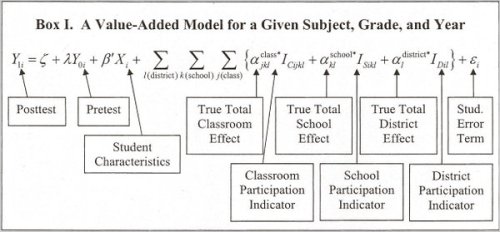Former news anchor turned education reform advocate Campbell Brown has established herself as one of the more aggressive public personalities arguing against teacher unions and in favor of school privatization. After leaving CNN in 2010, Ms. Brown reemerged as an antagonist of teacher unions, taking to the pages of The Wall Street Journal to accuse New York City’s United Federation of Teachers of protecting teachers accused of sexual misconduct. It was a devastating line of attack against a favorite target of would be education reformers – a well-funded and politically connected labor union favoring its membership over ethics.
Of course, it wasn’t really true. Curiously, Ms. Brown seemed entirely unaware of the actual requirements in the UFT contact in effect at the time of her accusations. This information was made crystal clear when Ms. Brown tried to publicly back UFT President Michael Mulgrew into a corner on the issue – and got seriously dressed down for her misrepresentation of the union’s position and actions:
Mr. Mulgrew: “We have made sure that on an allegation, a single allegation, a teacher must be removed. If the principal wants the teacher removed, or the administrator, they must be removed from any contact with children. They then have a 30 day investigation period. If they are found guilty of any sort of sexual impropriety, any sexual impropriety, the administrating officer has no choice but to fire him. And those are the things that we put into our contract – that they must be fired if they are found guilty of any sexual impropriety. So I know you like to say things in certain ways, but I have found many of your allegations to be misleading. So I am very proud of the fact that we take very seriously that on a single allegation – a child can say it in a flippant moment — that that teacher will be removed from any contact with a student, and if they are found guilty of any sort of sexual impropriety – any – there is no discretion: they must be fired. And that is my answer to you.”
Ms. Brown: “So to clarify…”
Mr. Mulgrew: “That is my answer to you.”
Ms. Brown also came under fire for failing to disclose, as is typical in ethical journalism, her family connections to education reform and, specifically, anti-union education reform. Her husband is Dan Senor, who was a figure in the Bush administration serving as the spokesman for the Coalition Provisional Authority in Iraq, and at the time of Ms. Brown’s relaunching of herself as an education advocate, he was an adviser to the Mitt Romney campaign and a board member of Students First, New York – the Empire State branch of Michelle Rhee’s anti-union organization. Ms. Brown decided her best reply was to be snarky about the entire question of ethical journalism.
Ms. Brown returned to bring Vergara vs. The State of California style lawsuits against teacher tenure in New York and other locales, funneling dark money donations into her new organization “Partners for Educational Justice”. The new campaign came with a fresh round of publicity and interviews where she tried to make her case to the public. These were, charitably, as fact challenged as her previous efforts to paint the UFT as an organization dedicated to protecting sexual predators. According the Michigan State University education professor Alyssa Hadley Dunn, Ms. Brown was wrong on almost every relevant point of fact, misrepresenting the staffing challenges faced by urban school districts (they have trouble retaining experienced teachers rather than being plagued by incompetent ones with tenure), arguing that teachers must be bad in urban districts because standardized test scores are low (in reality, teachers are important but no research solidly ties quality of teaching to standardized test results), and citing wildly out of date information on how long it takes to remove a tenured teacher from the classroom (177 days is not 830 days no matter how often that talking point is repeated).
Shortly after launching her lawsuit, Ms. Brown also started her education “news” website called the “The74,” which oddly sounds like a nightclub but is supposed to “represent” the roughly 74 million Americans under the age of 18 in the country. The website is expected to operate on a budget of $4 million annually, and is funded by donors such as Bloomberg Philanthropies, the Walton Family Foundation, and Jonathan Sackler who serves on the board of the New Schools Venture Fund — all reliable sources of charter school support. From that platform, she has been billing herself as a viable host for education issues in the current election cycle, hosting a Republican candidate discussion in August last year – and blaming the national teacher unions for the fact that no Democratic candidates agreed to appear at a similar forum later in the Fall. Jersey Jazzman demonstrated the long list of entirely viable reasons why Democrats might not want to participate in what would obviously have been an anti-union, pro-privatization event hosted by a media figure whose relationship with facts has been sketchy. But blaming unions is sort of a reflex for Ms. Brown by now.
Most recently, Ms. Brown took to Slate with a video giving “advice” for the next President of the United States. In it, she said that two thirds of American eighth graders “cannot read or do math at grade level.” In response, Tom Loveless, an expert on student achievement and senior fellow at The Brookings Institution, demonstrated that her facts were inaccurate in an exchange on Twitter:
Former Principal and current head of the Network for Public Education, Carol Burris, explained the depth of Ms. Brown’s error in The Washington Post. During the exchange on Twitter, Ms. Brown admitted that her “source” for the claim about American students’ grade level skills came from the National Assessment of Educational Progress (NAEP) where, yes, roughly one third of American 8th graders meet the cut scores for “proficient” and “advanced” with two thirds at “basic” or below. As Burris notes, NAEP does not consider “proficient” to be synonymous with “grade level” skills and expectations. In fact, if you read the description of “basic” performance in the 8th grade reading NAEP, you will see a description of competent if not outstanding reading ability:
Eighth-grade students performing at the Basic level should be able to locate information; identify statements of main idea, theme, or author’s purpose; and make simple inferences from texts. They should be able to interpret the meaning of a word as it is used in the text. Students performing at this level should also be able to state judgments and give some support about content and presentation of content.
To set up the NAEP proficiency as an appropriate grade level benchmark as Ms. Brown does is to entirely muddy the discussion and debate about how our schools are doing. Such sleight of hand techniques seem deliberate and designed to paint a misleading portrait of our schools for reasons that have little to do with improving them for most children. Regardless of motives, one thing is completely clear: anyone trying to portray NAEP results – or PARCC and SBAC results for that matter – as an established proxy for what grade level expectations should be in our schools is either seriously misinformed or a liar.
Carol Burris spoke very cogently about why this matters beyond the question of truthfulness as well:
If you set an unreasonable cut score on state tests and pressure teachers and kids to meet it, it can work against student learning, especially for students who struggle. Sizeable numbers of kids will learn less than they might if the instructional pace and content were developmentally appropriate and well sequenced. This is especially true in the younger grades. You can always differentiate instruction if you need to for the kids who excel, but if you hold struggling learners to a standard they cannot meet, frustration, not learning, happens. Inappropriately difficult standards also promote drilling for the test, adult cheating and the narrowing of the curriculum as explained in this Politico New York report on the test-driven, Success Academy Charter Schools.
Despite the important arguments and issues of genuine substance, Ms. Brown seems determined to not learn about the education policies she has inserted herself into as both an advocate and an arbitrator. Given an opportunity to respond directly on her statements about student achievement, Ms. Brown offered perhaps the most childish and taunting string of non-sequiturs I have seen since I last taught 7th grade. She called the reaction to her use of “grade level” “histrionic,” misused the expression “begs the question,” taunted “is that all you’ve got?”to her critics, declared that public education advocates have “lost” on charter schools, tenure, and “special protections” for abusive teachers, and said the reaction “screams desperation.” She declared that any “reasonable person or parent” knew what she meant by her statement. She declared that she was subject to personal sexist attacks. She claimed critics were “feigning outrage” over her misuse of terminology and facts because they “profit off the system’s failure.” And for good measure, she compared New York University Professor Diane Ravitch with Donald Trump.
And your mother, I guess.
Ms. Brown’s self assurance is a bit odd here. The charter sector may be growing, but so is awareness of the scandals growing from scant oversight of finances and practices. Anti-union forces may have won the first round of Vergara v. California trying to sue tenure out of existence, but they lost the appeal. Ms. Brown’s comment about “special protections you want for abusive teachers” is literally just blather since she didn’t have her facts correct when she started the argument.
More interesting, however, is the complete absence of an actual argument. Ms. Brown grudgingly acknowledges that her specific language was incorrect, but she denies that anyone was really impacted at all by it. Mostly, she just insinuates that her critics are losers and complains about the tone of their comments to her. To be sure, she has received some personal, even heated, criticism in the course of these debates (although before equating Dr. Diane Ravitch’s occasional criticisms of her to what Donald Trump unleashes on his critics, she might want to consult the record). These issues, however, are of national importance, and Ms. Brown has a repeated and enthusiastic habit of getting critical facts dead wrong on issues that impact 3 million professional teachers and their 50 million students. From her assertion that the UFT happily protects child molesters to her statements about tenure to her claims about the percentage of American children reading and doing math at grade level, she is consistently and damagingly wrong.
Perhaps the actual facts are inconvenient for her cause, but smug snarkiness when called out for substituting “truthiness” for truth is hardly an argument.








